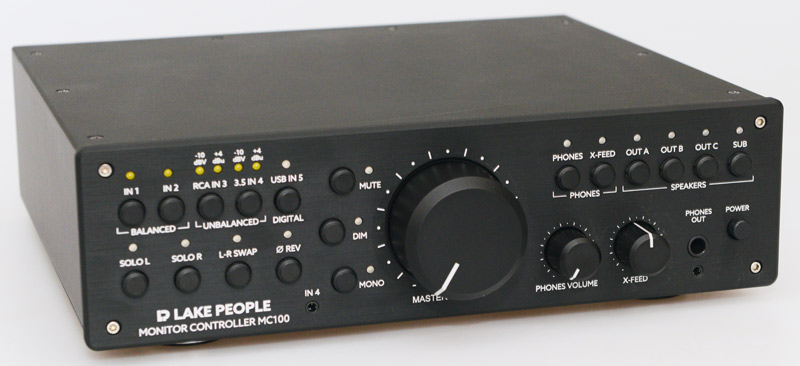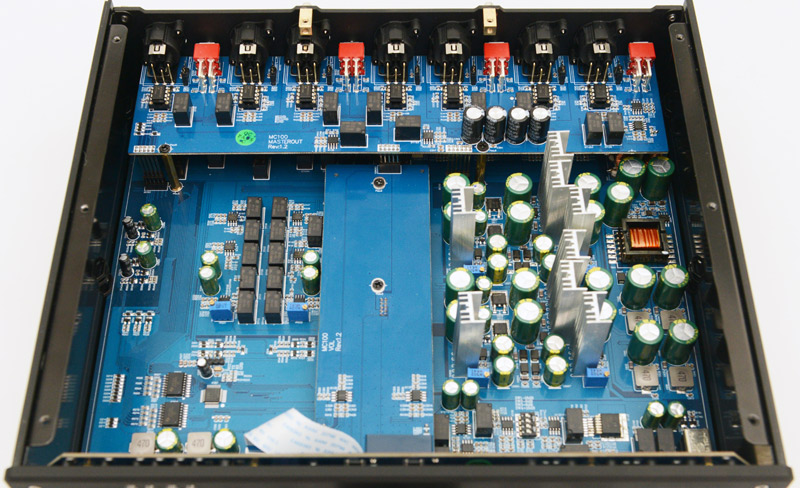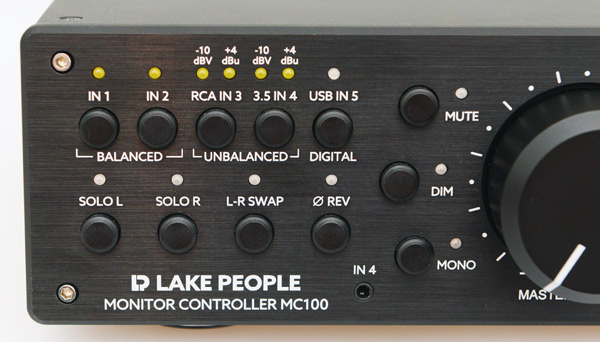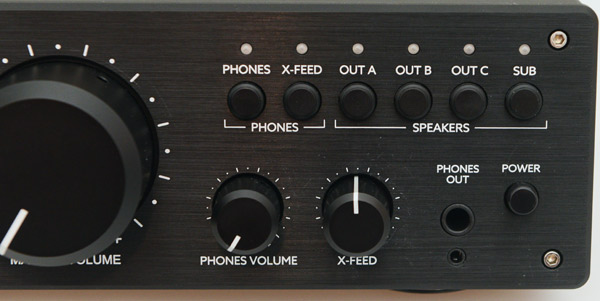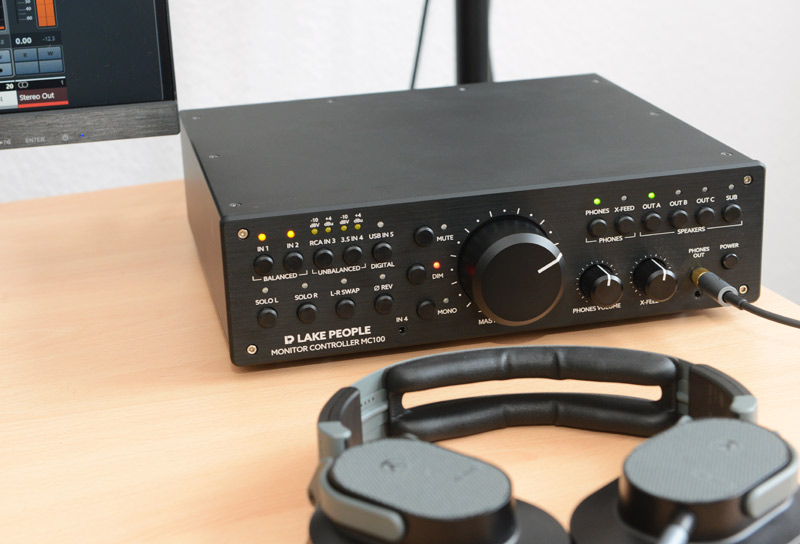Lake People Monitor Controller MC100
Author and photos: Peter Kaminski
It was in 1993 that a German company called Lake People introduced the PATCH-AMP F18, in which six inputs and outputs could be linked. An RIAA preamp and a headphone amplifier were also integrated, and the inputs and outputs could be calibrated using trimmers. In 2002, Lake People offered the Vol-Con F38, a 7.1 volume control with analog and AES3 inputs and a remote control. Therefore, the topic of monitor controllers is not entirely new to Lake People. In mid-2022, they are thinking about a monitor controller, and now, in 2023, it is available in the form of the MC100, which has some features inherited from other current products.
Concept and technology
The MC100's enclosure is made of black anodized aluminum (overall dimensions 290 x 90 x 282 mm). Lake People also offers a mounting frame to install the monitor controller into a 19-inch rack.
The Lake People MC100 can handle five inputs and three monitor outputs, as well as subwoofers and two slave stereo outputs. It has an integrated headphone amplifier. The circuitry is similar to that of the Lake People G105 MKII, which we have already reviewed, with an OPA551 power operational amplifier. Here, too, there is the option of setting a pre-gain in the range of -18 to +18 dB in 6 dB steps via DIP switches inside the case to determine an optimal control and drive range. The operating voltage of the OPA551 in the MC100 is +/-17.5 volts – so a level range of 35 volts (50 volts in the G105 MKII).
There are two versions of the MC100: the normal version, where the volume control for the monitor outputs is regulated by an Alps RK 27 potentiometer, and the Pro version, where a 256-step attenuator is used instead of the potentiometer, via a resistor network and relays, as we know it from the Violectric HPA V550 PRO. The Pro version with the relay attenuator is more complex and expensive, but it has some advantages worth mentioning: higher channel matching, higher setting precision, lower crossfeed, and no variable impedance at the output of the network as with a potentiometer.
Connections
With a monitor controller, the possibilities quickly become clear when you take a look at the possible connections, which we will now do.
First of all, let's look at the outputs. There are three balanced (XLR jacks) stereo outputs and a switchable subwoofer output (mono, XLR jack). Furthermore, two stereo slave outputs (XLR jacks) are available, which are buffered but not regulated. All outputs offer a maximum level of +26 dBu and an output impedance of < 1 Ω. The headphone output on the front panel is available as a 3.5 mm stereo jack, as well as a 6.3 mm stereo jack.
The ground/earthing conditions of all these outputs can be individually modified via jumpers, namely:
- Pin 1 is on the internal ground point, and a capacitor with 100 nF diverts HF interference signals to the housing,
- Pin 1 is not connected to the internal ground, and the capacitor is as before,
- Pin 1 is connected to the housing, and the 100 nF is bridged.
The level of all monitor outputs can be individually trimmed (0, -6, -12 dB) using a toggle switch.
The MC100 offers five different selectable inputs with an impedance of 10 kOhm and a maximum input level of +22 dBu:
- Two balanced stereo inputs (XLR jacks, ground/earth also adjustable via jumper),
- One unbalanced stereo input (RCA jacks),
- Another unbalanced input on the front panel (3.5 mm stereo jack)
- and a USB-C input.
The USB-C interface is Class Compliant and therefore does not require any additional driver installation. The A/D converter supports word lengths of up to 32 bits and sample rates of up to 384 kHz, as well as Direct Stream Digital in the DSD64, DSD128 and DSD256 formats.
An external power supply unit supplies the MC100 with 18 volts of DC voltage. The power supply unit automatically adjusts to the AC voltage (90... 250 V and 50... 60 Hz).
Operation
Now for the operation via the front panel controls. At the top left, the input sources can be selected. There are two different selection modes: mutual selection and multiple selection with the summation of the input sources. This can be toggled by pressing and holding the IN 1 and IN 2 buttons. The sensitivity of the unbalanced inputs (RCA on the rear and 3.5-mm jack on the front) can be adjusted between -10 dBV and +4 dBu. This is done by pressing and holding the RCA IN 3 or 3.5 IN 4 buttons.
Below that, there are switches for solo left and right, channel swap, and phase swap. On the left side of the volume knob, which is gridded in the standard version (41 grid points), the output signal can be switched to mono, muted (not on the headphones), and dimmed by -20 dB using buttons.
On the right side, you can switch the monitoring playout paths, namely the three monitor paths and the subwoofer playout path. Here, too, the three outputs can be operated in an alternating or multiple mode. This switchover is done by pressing and holding the OUT A and OUT B buttons.
The headphone amplifier is independent of the level of the main volume control and has its own headphone level control. A switch allows you to activate crossfeed and adjust its strength using a knob. This is designed to enable playback on headphones that is similar to that on loudspeakers, reducing the in-head localization.
Practice
We had already received a model from the first test production batch, which corresponds to the series model both technically and in terms of overall design. The frequency range has been limited to 5 Hz... 70 kHz (-0.5 dB). Let's take a look at a few more technical data (values in RMS, frequency range 20 Hz... 20 kHz and pre-gain set to 0 dB default settings) that we have not yet mentioned. The dynamic range of the G108 is > 120 dB, with an inherent noise level of < 103 dBu. The crossfeed at 1 kHz is 105 dB, as stated by the manufacturer.
A useful feature is that there is a five-second delay before the monitor outputs and headphone output are switched on, and an immediate disconnection when they are switched off. This prevents the destruction of loudspeakers and headphones, as well as causing hearing damage. The headphone amplifier's output power is, of course, dependent on the connected impedance at 1 kHz and 0.1% THD+N. At 100 Ω connection impedance, the output power is 2.25 W, at 50 Ω it is 1.62 W and at 32 Ω it is 1.10 W. In any case, the integrated headphone amplifier is of very high quality, almost on par with that of the G105 MKII. The differences are minimal at the limits of operation.
Operation is simple and well thought out, and thanks to the programmability of the key functions for sources and sinks, also flexible enough. The ability to turn off the headphone amplifier with the push of a button is a handy feature that is not available on all monitor controllers from other manufacturers. The rasterized level knob can be adjusted very precisely. Whether or not to use the X-Feed function is certainly an individual decision. With the focus on XLR connectors, the needs of professional users are also in mind.
Conclusion
The price for the standard version with potentiometers is around 1,800 euros, while the pro version with relay attenuators is 2,400 euros. This is absolutely reasonable for the workmanship and the technical quality offered, and the Lake People MC100 also meets higher demands.
 How to resolve AdBlock issue?
How to resolve AdBlock issue? 